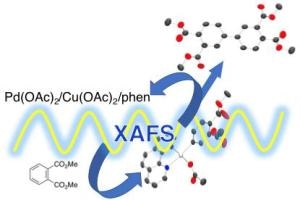May 23 2018
Aromatic polyimide is a polymer that is known for its high mechanical strength and excellent chemical- and thermal-resistant properties. The polymer is extensively used for aerospace materials and electrical insulation materials.
 Synchrotron radiations shed light on the mechanism for dehydrogenative coupling of dimethyl phthalate catalyzed by palladium and copper complexes. (Image credit: Department of Applied Chemistry, Graduate School of Engineering, Tokyo University of Agriculture and Technology)
Synchrotron radiations shed light on the mechanism for dehydrogenative coupling of dimethyl phthalate catalyzed by palladium and copper complexes. (Image credit: Department of Applied Chemistry, Graduate School of Engineering, Tokyo University of Agriculture and Technology)
Tetramethyl biphenyltetracarboxylate is used for making one of the key polyimides and this is prepared through dehydrogenative coupling of dimethyl phthalate catalyzed by traditional [Pd(OAc)2]/[Cu(OAc)2]/1,10-phenanthroline (phen) system. Yet, the product yield is usually less than 10%. But despite this fact, this process is still employed for the industrial production. Since the process calls for adverse conditions (more than 200 °C), extremely diluted catalyst conditions and cross-linked catalyzes using Cu and Pd complexes, the mechanism had remained largely unknown.
This mechanism is now explained by synchrotron radiations. Researchers from TUAT, Kyoto University, and Osaka University have Initially concentrated on the potential intermediates, for example, [Pd(OAc){C6H3(CO2Me)2}(phen)] based on the commonly accepted catalytic cycle and they prepared them by separate reactions. Certain stoichiometric reactions utilizing the potential intermediates proposed the formation of the product, tetramethyl biphenyltetracarboxylate, through subsequence of disproportionation giving Pd{C6H3(CO2Me)2}2(phen) as well as reductive elimination.
The researchers confirmed that as the turn over numbers (TONs) and the catalysts reached to 91, these potential intermediates are able to work. Using the synchrotron radiations of SPring-8 BL01B1 at Japan Synchrotron Radiation Research Institution, the researchers also utilized Pd K-edge (24.357 keV) XANES and EXAFS measurements and eventually observed that an in situ catalyst solution in dimethyl phthalate beginning from [Pd(OAc)2]/[Cu(OAc)2]/phen changed into [Pd(OAc){C6H3(CO2Me)2}(phen)] by the XAFS study. This novel technique and results have been reported in the ACS Catalysis.
This process has been used for an industrial production of an aromatic polyimide precursor, despite of the low catalytic efficiency. This is an awesome process originally found by industrial researchers for production of the precursor because of high atom efficiency and direct access from readily available dimethyl phthalate. Our results are surely service to the further development on the catalysts, that leads to the more economical production of the polyimide. Although some pioneering groups have studied the related catalyzes, we are glad to contribute some.
Masafumi Hirano, Principal of the Study & TUAT professor of Chemistry
However, the present scope is restricted to the Pd catalyst side. While the comprehensive study on the Cu catalyst is more complicated, this is the only method to gain a perfect understanding of this catalysis.
The in-situ solution XAFS analysis of homogeneous catalyzes is still difficult but our team works well in all stages in organometallic chemistry, catalytic chemistry, and the XAFS study. I appreciate the diversity of the team members with different backgrounds in chemistry.
Masafumi Hirano, Principal of the Study & TUAT professor of Chemistry
Other authors of the study are Dr. Nobuyuki Komine, a research associate in TUAT; Yuki Kanazawa and Kousuke Sano, graduate course students in TUAT; Dr. Zen Maeno (now promoted at Hokkaido University); Prof. Hikaru Takaya in Kyoto University; and Prof. Takato Mitsudome in Osaka University.
The study was funded by Grant-in-Aid for Scientific Research on Innovative Areas, "3D Active-Site Science" 26105003 from the Ministry of Education, Culture, Sports, Science and Technology, Japan.